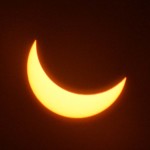by Erich Karkoschka
 Mercury is easy to see in the northwest in the evening below Castor and Polux at the beginning of June between 8 and 9 pm. It can be spotted until June 15.
Mercury is easy to see in the northwest in the evening below Castor and Polux at the beginning of June between 8 and 9 pm. It can be spotted until June 15.
 Venus gets so close to the sun that it occults part of the solar corona on the 3rd, the only time until the 22nd Century. Starting on the 9th, it will be the morning “star”, when it will be only 1% illuminated. A beautiful, large, and thin crescent, visible even in small binoculars. Its illumination increases to 18% by the end of the month when it reaches almost maximum magnitude. A special event will be June 19 when the extremely thin crescent Moon will rise 2 degrees below Venus at 4 am. Venus will be obvious while the Moon will be pale as dawn brightens.
Venus gets so close to the sun that it occults part of the solar corona on the 3rd, the only time until the 22nd Century. Starting on the 9th, it will be the morning “star”, when it will be only 1% illuminated. A beautiful, large, and thin crescent, visible even in small binoculars. Its illumination increases to 18% by the end of the month when it reaches almost maximum magnitude. A special event will be June 19 when the extremely thin crescent Moon will rise 2 degrees below Venus at 4 am. Venus will be obvious while the Moon will be pale as dawn brightens.
 A Moon/Venus conjunction will take place the morning of June 19 before dawn. The Moon is full June 5, Last Quarter June 13, New June 21, and First Quarter June 28.
A Moon/Venus conjunction will take place the morning of June 19 before dawn. The Moon is full June 5, Last Quarter June 13, New June 21, and First Quarter June 28.
 Mars rises later but climbs up higher then Jupiter and Saturn by dawn. Mars is brightening toward its October close opposition. Only Venus and Jupiter are brighter than Mars.
Mars rises later but climbs up higher then Jupiter and Saturn by dawn. Mars is brightening toward its October close opposition. Only Venus and Jupiter are brighter than Mars.
 Jupiter rises around 10 pm, by 9 pm later in June. Jupiter and Saturn are only 5 degrees apart. Jupiter is three magnitudes brighter than Saturn.
Jupiter rises around 10 pm, by 9 pm later in June. Jupiter and Saturn are only 5 degrees apart. Jupiter is three magnitudes brighter than Saturn.
 Saturn rises around 10 pm, by 9 pm later in June. Jupiter and Saturn are only 5 degrees apart. Saturn is three magnitudes dimmer than Jupiter.
Saturn rises around 10 pm, by 9 pm later in June. Jupiter and Saturn are only 5 degrees apart. Saturn is three magnitudes dimmer than Jupiter.
 Uranus rises two hours later than Neptune and is still low when dawn starts.
Uranus rises two hours later than Neptune and is still low when dawn starts.
 Neptune is 1.6 degrees to the northwest of Mars on the 13th.
Neptune is 1.6 degrees to the northwest of Mars on the 13th.
 Asia and Africa will experience a solar eclipse on June 21st. It is an annular eclipse, so not quite total. An annular is when the Moon doesn’t quite cover the Sun and there is a small ring of the Sun around the Moon.
Asia and Africa will experience a solar eclipse on June 21st. It is an annular eclipse, so not quite total. An annular is when the Moon doesn’t quite cover the Sun and there is a small ring of the Sun around the Moon.

